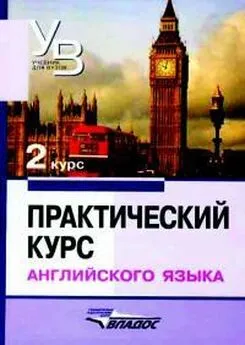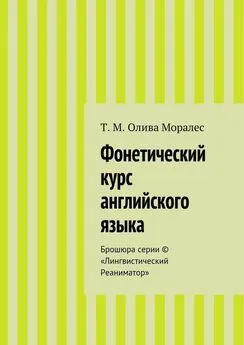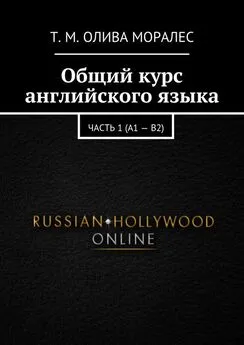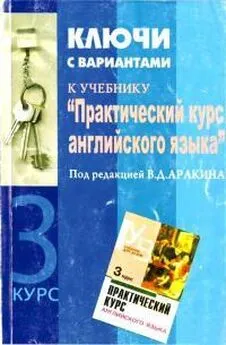Яков Аракин - Практический курс английского языка 2 курс
- Название:Практический курс английского языка 2 курс
- Автор:
- Жанр:
- Издательство:ВЛАДОС
- Год:2005
- ISBN:нет данных
- Рейтинг:
- Избранное:Добавить в избранное
-
Отзывы:
-
Ваша оценка:
Яков Аракин - Практический курс английского языка 2 курс краткое содержание
I - V курсов педагогических вузов.
Цель учебника – обучение устной речи на основе развития необходимых автоматизированных речевых навыков, развитие техники чтения, а также навыков письменной речи.
Практический курс английского языка 2 курс - читать онлайн бесплатно полную версию (весь текст целиком)
Интервал:
Закладка:
II. Fill in appropriate words (consult the list of synonyms on pp. 291— 292):.
VII. Role-playing.
Work in groups of four or five:
VIII. Translate the following into English:
IX. Make up dialogues.
X. а) Translate the following fragment into Russian in written form:
XI. a) Read the text below and translate it into Russian orally:
b) Answer the following questions:
c) Point out the Hues and passages that you consider humorous. Is it humour of situation or humour of words! (Analyse each case separately.)
XII. Speak individually or arrange a discussion on the following:
ХIII. Try your hand at teaching.
1. Arrange and run a conversation on the following text:
XIV. A. Do yon know how to act sensibly when out in the wilds? If not, the text below might help you:
B. Describe the pictures. Use the suggested phrases.
С See if the travellers have acted sessibly. Support your idea.
UNIT NINE
I. Change the sentences, using the patterns:
II. Think of a situation. Suggest a beginning matching up the end. Use the proper pattern:
III. Translate the following into English. Use the patterns:
IV. Respond to the following statements and questions, using the patterns:
V. Write 12 questions suggesting answers with these patterns. (The questions in Ex. IV may serve as a model.)
TEXT. ROSE AT THE MUSIC-HALL From "They Walk in the City" by J. B. Priestley
1. Bead the text and explain the following points (A. Grammar, B. Word usage, С. Style):
II. Transcribe the following words and translate them into Russian:
III. a) Find in the text sentences with:
and write your own sentences with the same word-combinations,
b) Find in the text sentences with:
and write your own sentences with the same words and phrases.
IV. Answer the questions:
V. Search the text for adjectives and classify them into two groups according to "positive" and "negative" qualities as suggested by the context (e.g. 1) great, good, nice... and 2) cheap, creased...). When the list is ready, describe some place and its atmosphere using the adjectives of each group.
VI. Tell the story of Rose as your own experience in the past.
VII. Study Vocabulary Notes and a) translate the examples; b) give synonyms of:
c) give antonyms of:
d) give derivatives of:
VIII. Fill in with:
a) be anxious, worry, trouble, bother.
b) anxious and its derivatives:
с) attend and its derivatives:
d) entertain and its derivatives:
IX. Translate these sentences into Russian:
X. Translate these sentences into English, using the word way.
XI. Make up dialogues:
ХII. Insert prepositions or adverbs where necessary:
ХIII. Make up a story, using the words and phrases from Essential Vocabulary I.
XIV. Translate the following sentences into English:
XV. Test on synonymy. Consult Notes on pp. 18 and 201.
XVI. Go over the text again and try to discuss the following:
XVII. a) Translate the text into Russian:
b) Comment on the following aspects of the fragment:
c) Comment on the literary merit and style of the fragment. Do you think that the author has managed to create a vivid and emotionally charged picture of a ballet performaAcet (Give reasons for whatever you say.) Which lines do you consider especially expressive? Why? What stylistic devices can you point out in the extract?
XVIII. Write an essay describing a person's first visit to a ballet (opera, drama) performance or to a symphony concert. Try to imitate the style and manner of the fragment above (you may borrow some phrases from it).
TOPIC: THEATRE
I. Answer the following questions:
II. Try your band at teaching:
III. Learn Text В by heart. Act out this dialogue.
IV. Retell Text С in your own words.
V. Translate the following into English:
VI. Read the following and either agree or disagree with the statements. (See the Reminder.):
VII. a) Describe your impressions of a play (opera, ballet) you have seen. Follow the plan below:
b) Make up dialogues discussing the points above.
VIII. a) Supply articles where necessary:
b) Answer the following questions:
IX. a) Give a free translation of the following passage. Make use of the English phrases given at the end:
b) What can you say about the significance of the event described above for the history of Russian and world theatre?
X. a) Read Sir Laurence Olivier's answers given by him in a newspaper interview:
b) Try your hand at teaching:
XI. Sole-playing.
XXI. a) Translate the following fragments into Russian (in writing)!
b) Comment on the fragments above.
ХIII. Speak individually or arrange a discussion on the following:
XIV. Try your hand at teaching. 1. Say what you would do in the teacher's position:
2. Respond to the following modestly. Here are a few possible ways of beginning answers:
3. Classroom English. (Revision);
XV. Describe these pictures: Use the following:
XVI. Film "Mr. Brown's Holiday". Film segments 9 "One More Substitute" (Yeovil) and 10 "Back at Ноmе" (London), a) Watch and listen, b) Do the exercises from the guide to the film.
SUPPLEMENT
A. CLASSROOM ENGLISH
I. Pupil Language
1. Following the Lesson
2. Correctness of Answers
3. Language Questions
4. Politeness
II. Beginning of Lesson
III. End of Lesson
IV. Blackboard Activity
V. Slides, Pictures, Films
VI. Textbook Activity
VII. Class Control
VIII. Right /Wrong
IX. Assessment
X. Conversation
B. CONVERSATIONAL PHRASES
1. Handling a Dialogue
2. Reacting to News
3. Discussion. Opinions
4. Agreeing. Disagreeing
5. Giving Advice
EXERCISES IN INTONATION
SECTION ONE. Review of Fundamental Intonation Patterns and Their Use
I. Read the following conversational situations. Define the communicative type of the replies. Say what attitudes are conveyed in them. Give your own replies to the same conversational contexts;
2. Read the following dialogues. Express the suggested attitudes:
3. a) Listen to the dialogue. Mark the stresses and tunes. Find sense-groups and sentences pronounced with intonation Patterns I, II; III, IV, V, VI, VII, VIII. Say what kind of sentences they are used in. Define the attitudes expressed in them:
b) Record your reading of the dialogue. Play the recording back for the teacher and your fellow-students to detect the possible errors. Practise the dialogue for test reading. Memorize and dramatize it.
c) Make up conversational situations, using the following phrases:
d) Use the same phrases in a conversation.
4. This exercise is meant to develop your ability to hear and reproduce intonation in different speech situations.
5. This exercise is meant to test your ability to read and reproduce a story with correct intonation.
SECTION TWO. Intonation Pattern IX. High fall
1. listen carefully to the following conversational situations. Concentrate your attention on the intonation of the replies:
2. Listen to the replies and repeat them in the intervals. Start the fall high enough.
3. Listen to the Verbal Context and reply to it in the intervals.
4. In order to fix Intonation Pattern IX in your mind, ear and speech habits, pronounce each reply several times until it sounds perfectly natural to you.
5. Listen to a fellow-student reading the replies and point out his (her) errors in pronunciation.
6. Listen to the Verbal Contest said by a fellow-student. Make your replies sound lovely, warm, airy. Use the proper intonation patterns. Continue the exercise until everyone has participated:
7. Give your own replies to the Verbal Context above. Use Intonation Pattern IX in them.
8. Use Intonation Pattern I in the Drills. Observe the difference in attitudes.
9. This exercise is meant to revise the intonation patterns you already know. Work in pairs.
10. Practise the following dialogues. Use the High Fall in them. Observe the attitudes you convey:
11. Listen to the Verbal Context suggested by the teacher. Reply by using one of the drill sentences below. Pronounce it with Intonation Pattern IХ. Say what attitude you mean to render;
12. Make up a dialogue of your own, using some of the phrases from Ex. 10.
13. This exercise is meant to develop your ability to hear and reproduce intonation in conversation.
14. This exercise is meant to develop your ability to hear and reproduce intonation in reading.
15. Mark stresses and tunes in the following text, listen to the model. Mark the stresses and tunes. Compare your intonation with that of the model. Practise the text according to the model:
16. This exercise is meant to develop your ability to hear intonation and reproduce it in different speech situations.
17. This exercise is meant to test your ability to analyse and reproduce material for reading and retelling.
SECTION THREE. Intonation Pattern X (LOW PRE-HEAD+) RISING HEAD + HIGH FALL (+ TAIL)
7. Give your own replies to the Verbal Context of Ex. 1 and 6. Use Intonation Pattern X.
8. The teacher or one of the students suggests a Verbal Context The students reply to it in turn using:
9. Read the following extracts. Observe the position of the logical stress:
10. Look for similar situations in the books you are reading at the moment
11. This exercise is meant to practise the intonation patterns you already know.
12. This exercise is meant to develop your ability to bear and reproduce intonation in different speech situations.
13. This exercise is meant to revise Intonation Pattern IX. Read the following dialogue. Use the High Fall to express personal concern, involvement:
14. This exercise is meant to develop your ability to hear intonation and reproduce it in different speech situations.
15. This exercise is meant to test your ability to analyze material for reading.
SECTION FOUR. Intonation Pattern XI (LOW PRE-HEAD + ) FALLING HEAD+ HIGH FALL (+ TAIL)
1. Listen carefully to the following conversational situations. Concentrate your attention on the intonation of the replies:
7. Read the following dialogue with a fellow-student» using Intonation Pattern XI. Special questions should sound interested, lively, brisk. The replies sound lively, friendly and warm:
8. A student will read the Verbal Context below. Other students will read the replies in turn, using the High Fall and the logical stress on the same word to make the utterance emphatic. Define the attitude you are trying to express:
9. Listen to your teacher read the context sentences below. Pronounce each of the following replies in two ways: first with Intonation Pattern II, then with Intonation Pattern XI. Observe the intonation line. Convey the suggested attitudes:
10. Listen to a fellow-student say the context sentences below. Pronounce each of the following replies, trying to convey the suggested attitudes. Be careful with the intonation line. Define the Intonation Pattern of your reply:
12. This exercise is meant to develop your ability to hear and reproduce intonation in conversation.
13. Translate into English. Use the corresponding phrases from item(d) above. Do not let your Russian pronunciation habits interfere:
14. Head the following dialogue:
15. Make up a dialogue of your own, using some of the phrases of the dialogue above.
16. This exercise is meant to develop your ability to read and retell a story with correct intonation.
17. This exercise is meant to test your ability to analyze and reproduce material for reading and retelling.
Читать дальшеИнтервал:
Закладка:





![Владимир Аракин - Практический курс английского языка 3 курс [calibre 2.43.0]](/books/1072035/vladimir-arakin-prakticheskij-kurs-anglijskogo-yazyk.webp)




